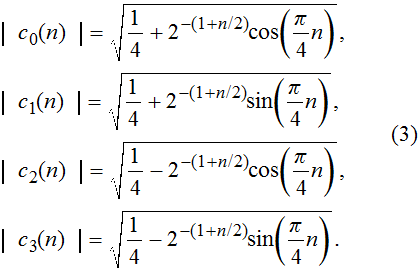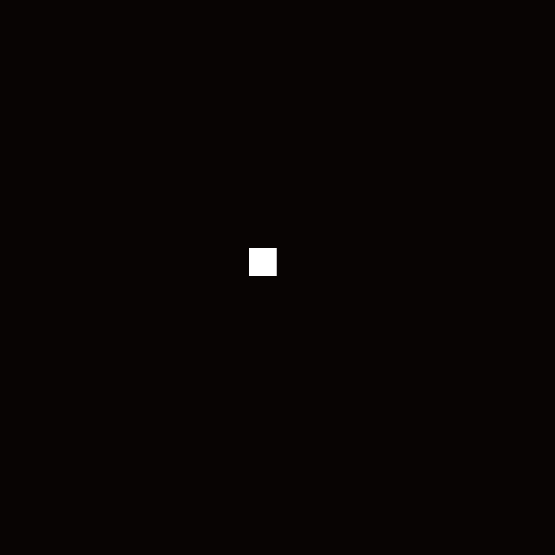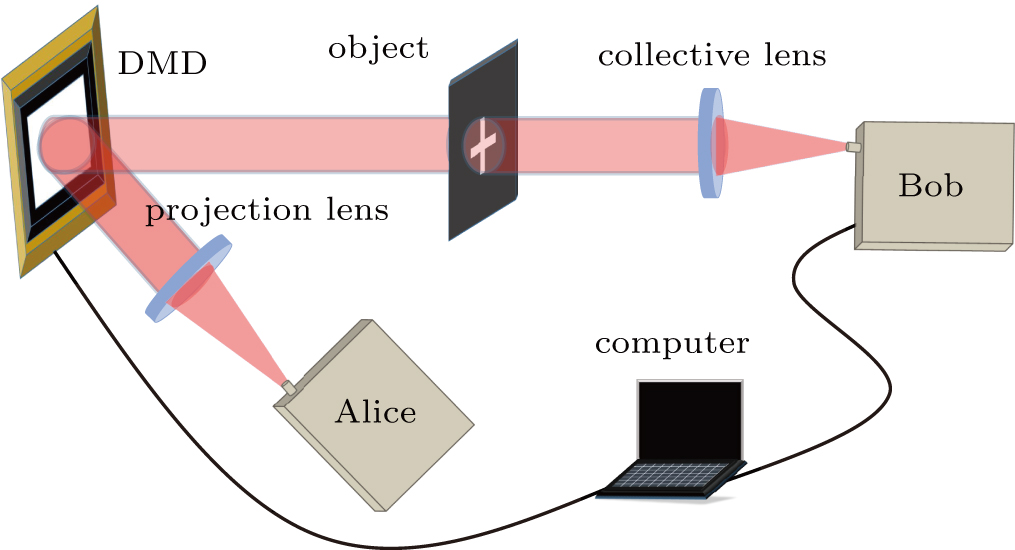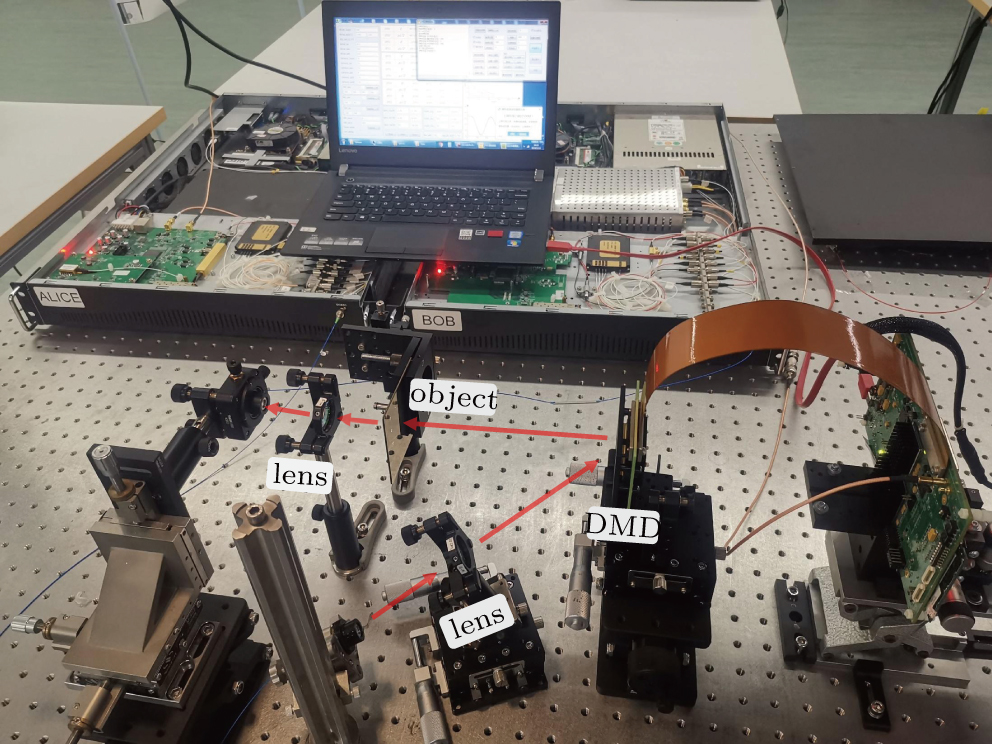† Corresponding author. E-mail:
We present a quantum secure imaging (QSI) scheme based on the phase encoding and weak+vacuum decoy-state BB84 protocol of quantum key distribution (QKD). It allows us to implement a computational ghost imaging (CGI) system with more simplified equipment and reconstructed algorithm by using a digital micro-mirror device (DMD) to preset the specific spatial distribution of the light intensity. What is more, the quantum bit error rate (QBER) and the secure key rate analytical functions of QKD are used to see through the intercept-resend jamming attacks and ensure the authenticity of the imaging information. In the experiment, we obtained the image of the object quickly and efficiently by measuring the signal photon counts with a single-photon detector (SPD), and achieved a secure key rate of 571.0 bps and a secure QBER of 3.99%, which is well below the lower bound of QBER of 14.51%. Besides, our imaging system uses a laser with invisible wavelength of 1550 nm, whose intensity is as low as single-photon, that can realize weak-light imaging and is immune to the stray light or air turbulence, thus it will become a better choice for quantum security radar against intercept-resend jamming attacks.
How to enhance the anti-jamming ability of radar is an urgent problem to be solved in the traditional radar countermeasures technology.[1,2] In the last two decades, with the intensive research and development of the techniques of quantum communication,[3–5] quantum imaging,[6–22] and quantum radar,[23,24] a series of results have been obtained, which provide a solution for improving the anti-jamming ability of radar.
In 1995, quantum imaging was first observed,[6] also known as ghost imaging (GI). Entangled photon pairs produced by spontaneous parametric down-conversion were used, while one of the photons passing through the object was collected by a photon counter or a bucket detector with no spatial resolution (called the signal beam or object beam), its twin photon was detected by a multipixel detector [e.g., a charge-coupled device (CCD) camera] without ever passing through the object (called the reference beam). Nevertheless, by correlating the intensities measured by the bucket detector with the intensities of each pixel in the multipixel detector, an image of the object was reconstructed.[6] In a long time, entanglement swapping was considered as the necessary condition for GI.[25] However, from 2002 GI was implemented by classical light sources,[9–18] especially the groups of Wang,[12] Wu,[13] and Han[14,15] accomplished a large numbers of GI experiments based on pseudo-thermal or real thermal light sources, which proved that entanglement is not the one and only way to achieve GI. After then,computational ghost imaging (CGI) was proposed[19] and verified by experiments,[20,21] which could be deployed with only one optical beam and one detector with no spatial resolution by replacing the reference beam with a controllable and pre-modulated light source.[22] The greatly simplified imaging system reduces the number of preset patterns and the imaging computational complexity, and then raises the imaging efficiency.[22] Based on the above, CGI and quantum secure imaging (QSI) could be applied to radar imaging faultlessly. Reference [8] introduced an anti-jamming quantum radar imaging (QRI) that utilized the BB84 protocol quantum key distribution (QKD) based on polarization encoding, which could verify the authenticity of imaging information by detecting the consistency of photon polarization states between the sender and the receiver. Up to now, the BB84 protocol is the most mature and widely used quantum key distribution protocol and its theoretical security has been fully proved.[26,27] Therefore, intercept-resend attacks are exposed immediately and the authenticity of the imaging information can be guaranteed through combining the CGI and QKD on radar technology. In addition, the quantum imaging technology has many advantages of higher resolution, higher contrast, higher signal-to-noise ratio (SNR), and less influence of atmospheric turbulence[7] compared with the traditional imaging. QSI will has great application value in the fields of aerial detection, military reconnaissance, and battlefield imaging in the future.
Inspired by Ref. [8], we present a QSI scheme combining the phase-encoding BB84 QKD and CGI technology. Unlike the original scheme, our scheme adopt phase-encoding QKD, in which the relative phase is rather stable against disturbance. Moreover, owing to the fact that perfect single-photon source is still unavailable, a pulsed laser source with Poisson distribution is used in the QKD system. By combing the decoy-state method, we can estimate the contribution of the multi-photon part to obtain the lower bound of QBER under the intercept-resend jamming attack, which is tighter than the origin one. In our experiment, a digital micro-mirror device (DMD) with quick response speed is used to preset the specific spatial distribution of the light intensity, and a single-photon detector (SPD) with quick response speed is used to measure the total light intensity, eventually the image of the object is retrieved through calculating the intensity distribution and the total intensity of light. Comparing with the traditional ghost imaging (TGI), QSI has been greatly improved in the data sampling rate and reduced in the imaging algorithm complexity and shortened the imaging time. More importantly, the quantum bit error rate (QBER) and the secure key rate of QKD are obtained in the experiment to see through the intercept-resend jamming attacks and ensure the authenticity of the imaging information.
The QSI system contains the imaging system and the QKD system, as shown in Fig.
Quantum key distribution technology is one of the most mature and commonly used communication methods in quantum communication, as well as the BB84 protocol in QKD protocol, whose theoretical security has been fully proved.[26,27] So, we adopt the scheme based on the phase encoding BB84 protocol of QKD.[3,4] Our QKD system is shown in Fig.
According to the phase encoding BB84 protocol, the relative phase on Alice is selected randomly from four values 0, π/2, π, and 3π/2, where 0, π are in the Z basis, and π/2, π/2 are in the X basis. Bob measures the incoming quantum states from Alice also in Z or X basis randomly. Whenever Alice and Bob use the same basis, the two SPDs will get correct results with a small QBER. However, when they use different bases, the two SPDs will get an uncertain result together. Alice then reveals only whether or not the state in which she encoded that qubit is compatible with the basis announced by Bob. If the state is compatible, they keep the bit; if not, they disregard it. In this way, fifty percent of the bit string is discarded. This shorter key obtained after basis reconciliation is called the sifted key.
In the practical QKD system, Alice uses the weak coherent source (WCS) together with the decoy-state method to substitute the unavailable single-photon source. The photon number of each pulse follows the Poisson distribution. The probability of finding an n-photon state in a pulse is given by 
 |


In the case of quantum secure imaging or quantum radar, the potential attacker usually adopts the intercept-resend strategy to forge the target. Since the QKD system is applied to enhance its security, here we just consider the intercept-resend quantum eavesdropping strategy that was proposed by Curty et al.[29] Eve’s attack strategy can be decomposed into three steps. In the first step, Eve obtains the total photon number n of each pulse sent by Alice via a quantum non-demolition (QND) measurement without introducing any errors. Then she performs a filter operation on the state 
 |










 |
For different states 




 |


The analysis for the case of n = 2 is similar. The coefficients 




 |

In order to give the lower bound of total error rate of the signal state at the present of intercept-resend attack, we adopt the model of decoy-state method to estimate the yield of photon pulses.[28] In the weak+vacuum decoy-state method, Alice randomly prepares the signal, decoy, and vacuum state with intensities of μ, ν, and 0, respectively. For 

 |
 |
By using the inequalities (
 |
The total error rate of the decoy state when Eve performs the intercept-resend attack is given by
 |

 |
Therefore, one can monitor the error rate of the decoy state, when the error rate of our QSI system is greater than 
CGI is an improvement from TGI. A spatial light modulator (SLM) or a CCD is used to preset the specific spatial distribution of the light intensity. Disregarding the reference beam, so just a single-pixel detector is needed.[20] In this imaging scheme, take the DMD to be a part of Alice. According to the security requirement of the decoy state BB84 protocol, the intensity of the laser pulses has to be lowered to the single-photon level at the exit of the DMD by an EVOA.
As in our scheme, a DMD is used to preset intensity patterns of speckles, and single-photon detectors are employed to measure the counts corresponding to each pattern. Suppose N is the number of intensity patterns modulated by the DMD, one can obtain the total count 

 |
 |
 |

The QSI system is set up as shown in Fig. 

 | Fig. 4. The simplest binary pattern loaded into the DMD that only one block is in the on state and the others are in the off state. |
After completing the connection of experimental devices as shown in Fig. 


| Table 1.
Experimental results of QKD procedure. . |
As can be seen from Table
At the same time, we can see that the image resolution is not high. The main reason is the serious diffraction effect of the DMD. As we know, the DMD is composed of many micro mirrors, which is similar to a two-dimensional diffraction grating. It has a strong diffraction effect on monochromatic light, and becomes stronger with the increase of the wavelength,[31] which can hardly even be used for imaging in the mid-infrared band. Therefore, even if all the micro mirrors of the DMD keep in the off state, the detector will still measure much energy due to the diffraction effect, which will greatly reduce the SNR and the imaging quality. As a result, neither the new block of the binary patterns can be too small, otherwise the diffraction noise will drown out the signal energy which makes the SNR relatively low. Nor the new block can be too large, otherwise the imaging resolution will be dissatisfactory. Therefore, it is necessary to find a balanced block in the experiment that makes the imaging quality best. In our experiment, the block with size of 
We propose a QSI scheme based on the phase encoding and weak+vacuum decoy-state BB84 protocol QKD that can resist the intercept-resend strategy of the jammers. The authenticity and safety of the imaging process are ensured by the theoretical unconditional security of QKD, and the QBER and the secure key rate analytical functions of QKD are used to estimate whether the jammer of object carries out the intercept-resend attacks. In our experiment, we obtain a secure key rate of 571.0 bps and a secure average QBER of 3.99%, which is below the lower bound of 14.51%. In the imaging system, we synthetically use the CGI scheme, SPDs and DMD both with faster response speed that greatly improve the imaging efficiency. This scheme is suitable for both objects with transmission or reflection. Furthermore, the system uses a WCS with invisible wavelength of 1550 nm, which can realize weak-light imaging and be immune to the stray light or air turbulence. Thus, it will become a better choice for quantum secure radar against jammers. But at the same time, it is undeniable that the more obvious diffraction effect of the DMD on the longer wavelength light will reduce the imaging SNR and quality. We believe that the diffraction effect can be minimized and the imaging quality can be improved by continuously adjusting the incident angle of light on the DMD, increasing the distance between the DMD and the detector, or designing the wavelength of the light to match the DMD.
| [1] | |
| [2] | |
| [3] | |
| [4] | |
| [5] | |
| [6] | |
| [7] | |
| [8] | |
| [9] | |
| [10] | |
| [11] | |
| [12] | |
| [13] | |
| [14] | |
| [15] | |
| [16] | |
| [17] | |
| [18] | |
| [19] | |
| [20] | |
| [21] | |
| [22] | |
| [23] | |
| [24] | |
| [25] | |
| [26] | |
| [27] | |
| [28] | |
| [29] | |
| [30] | |
| [31] |









